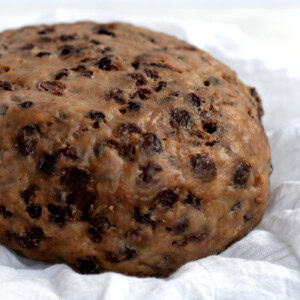
Clootie Dumpling
A truly unique Scottish dessert, with a somewhat different way of cooking it. That's what makes Clootie Dumpling delcious!
PRINT RECIPE
Servings: 12
EQUIPMENT
- Small Saucer (to sit at the bottom of your pot)
- Muslin Cloth (or similar)
- String or Twine (ensure it's food-safe)
- Baking Tray
INGREDIENTS
- 250 g Self-raising Flour (plus extra for dusting)
- 75 g Caster Sugar (Superfine Sugar)
- 50 g Suet (vegetable or beef)
- 30 g Breadcrumbs (fresh)
- 1 tsp Mixed Spice (Pumpkin Spice)
- 1/2 tsp Ground Cinnamon
- 170 g Raisins
- 120 g Currants
- 1 small Apple (peeled & grated)
- 1/2 tbsp Treacle (Molasses)
- 280 ml Milk (cold)
INSTRUCTIONS
- Place your saucer at the bottom of your pot and fill about half too two-thirds full of water. Set to boil, whilst you prepare your clootie dumpling.
- In a large bowl, add all the dry ingredients and the grated apple. Mix well until combined. Add the treacle and milk. Mix well until combined, and you have a sticky mixture. Set aside whilst you prepare your cloot (cloth).
- Take your cloot and dip it in your now-boiling water. Carefully remove the cloot with tongs and set it down to cool a little. Once cool enough to handle (but still warm), squeeze out the excess water, before laying your cloot onto a flat work surface. Sift a little extra flour over the top. You don't need flour from edge-edge/corner-corner but make sure the majority of your cloot is coated. Gently shake off the excess flour.
- Turn your dumpling mixture into the middle of your flour coated cloot, using your hands to shape it into a rough round shape. Take the corners of your cloot and pull them together, gathering the edges in too, making sure there's no gaps. Be careful not to pull your dumpling in too tight - you want to leave a little space for your dumpling to swell as it cooks. Tie your cloot with your string (see Granny's Top Tips for advice on how to do this efficiently).
- Place your dumpling into your pre-boiled pot of water, ensuring the entire dumpling is covered in water (top up with more boiling water if not). Reduce the temperature to a simmer and place the lid on your pot. Allow to simmer for 3 - 3½ hours. Keep an eye on your pot and top up with boiling water whenever the water is creeping below your dumpling.
- After 3 - 3½ hours, remove your dumpling from the pot and pop it onto your tray to cool for a short while, before removing the cloot. Be careful of your fingers because it will still be hot! Cut the string around your cloot and remove. Gently peel back the cloot from the dumpling, being careful not to peel off the skin too. Once you have peeled the cloot from the top and sides of the dumpling, use a plate to flip the dumpling and remove the cloot from the bottom, before returning it back to the baking tray, right-side up.
- Pre-heat your oven to 180°c (160°c for fan-assisted oven, Gas Mark 4 or 350°F) Allow your cloot to air-dry whilst your oven pre-heats and then place into your oven for about 20-30 mins, until the skin darkens and looks dry & shiny.
- Remove from the oven and allow to cool a little before serving in wedges, with custard or cream.
IMPORTANT NOTE:
All my recipes are developed using a digital scale and the metric system (grams and millilitres). Cup measurements are available as a conversion but these, unfortunately, won't always be as accurate. For best results, I always recommend baking with a digital scale.
RECIPE NOTES:
- For full ingredient explanations, including substitutes, please see the Ingredients information above.
- For all our tips in achieving an authentic Clootie Dumpling, please see Granny's Top Tips above.
- For ways to make this a vegan Clootie Dumpling, see the Free-from & Vegan hacks below.
- Clootie Dumpling can be kept in an air-tight container, in the fridge for up to one week. It can be eaten cold but is best enjoyed when warmed up before serving (either in the microwave, or in the oven wrapped in tin foil).
- Clootie Dumpling can be frozen for up to 6 months. For ease, cut it into wedges, wrap well in clingfilm/tinfoil, and freeze individually. Defrost before serving. Again, it is fine to eat cold but best enjoyed when warmed up (either in the microwave, or in the oven wrapped in tin foil).
Tried this recipe?Tag @bakingwithgranny or use the hashtag #bakingwithgranny!
Pin recipe for later